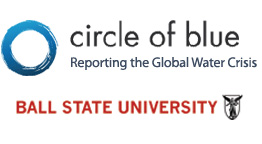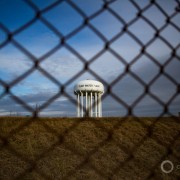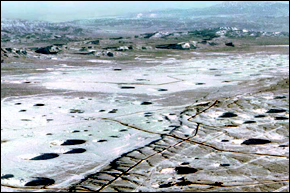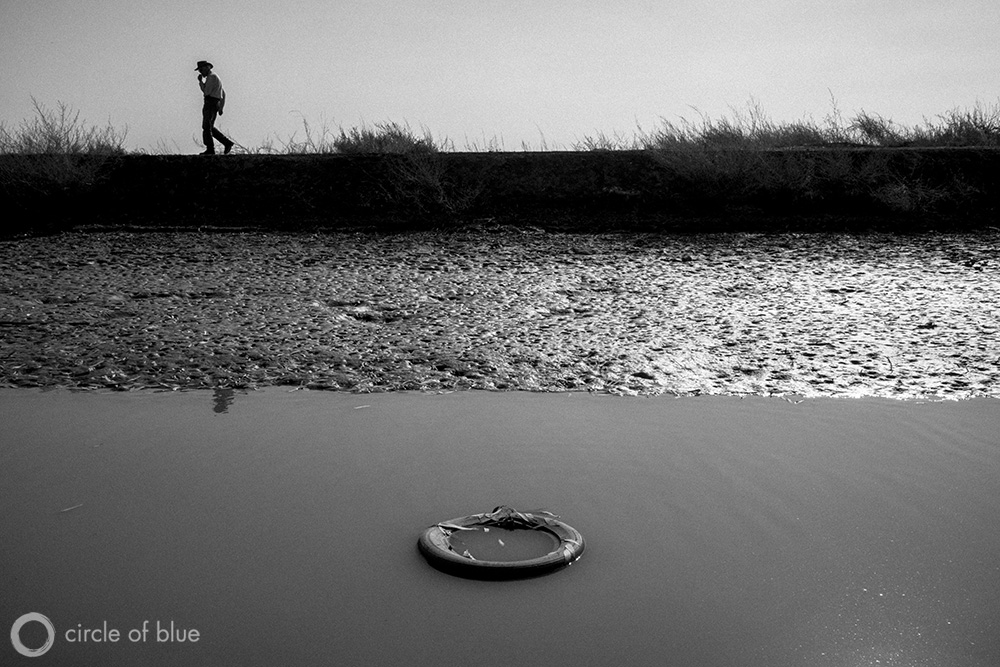Is U.S. Groundwater Quality Getting Better or Worse? It’s Hard to Say
Too little data so far for main national monitoring network.

Illinois fields catch the first rays of daybreak. Runoff from farm fields contributes to rising nitrate levels in groundwater. Photo © J. Carl Ganter/Circle of Blue
By Brett Walton, Circle of Blue
After nearly three decades of groundwater monitoring, the federal government’s foremost Earth science agency has collected enough data to begin identifying long-term pollution trends in the country’s largest aquifers.
A few trends, that is, but not many. Not enough data have been collected to state with certainty whether quality is improving or worsening. Two clear patterns that the U.S. Geological Survey’s National Water Quality Assessment found are that concentrations of chloride and sodium are climbing nationally, while in farm regions in California and southern Georgia, nitrate levels have increased.
Congress ordered the agency in 1991 to track long-term changes in the nation’s groundwater quality — and for good reason. Some 155 million people today, nearly half of the country’s population, use groundwater for drinking water. A quarter of that number, roughly 42 million people, use household wells, which are not regulated.
There is no comparable long-term national assessment of groundwater quality, according to Bruce Lindsey, who oversees the monitoring program. But the program has limits. To start with, though more than 200 contaminants are monitored, trends are calculated for a small number of nationally or regionally important contaminants: only 25, including pesticides, heavy metals, nutrients, and volatile organic compounds. New chemicals of concern, such as toxic PFAS compounds, which have drawn attention from Congress and are found in the drinking water of millions of Americans, are not included. Second, the monitoring program is designed to look broadly at the country’s biggest, most important aquifers, which are those used for irrigation and drinking water by large numbers of people.
The wide-angle view captures the big picture, but that means that local changes, profoundly important on their own, can be obscured. The program, for example, does not target Superfund sites, Lindsey said.
Other researchers are gathering more evidence that individual sites, be they waste dumps, factories, chemical plants, dry cleaners, underground oil storage tanks, military bases, or airports, are spoiling local groundwater on a scale too small to register in the national evaluation but large enough to contaminate wells used by households, municipalities, and farmers.
A report released earlier this month from the Environmental Integrity Project, a nonprofit watchdog group, found that out of 265 coal ash pits reporting data, more than 90 percent polluted nearby groundwater with at least one chemical above federal drinking water standards.
The Defense Department, meanwhile, counts 401 bases where military officials suspect that PFAS compounds were released into groundwater.
A more extensive survey of contaminated sites by the National Academy of Sciences, in 2013, found more than 126,000 locations across the country with groundwater that requires cleanup. Approximately 10 percent of those sites are so extensively polluted and geologically and technically challenging that restoration may take a century. Michael Kavanaugh, who chaired the report committee, told Circle of Blue that he does not think the number of sites with groundwater contamination has decreased substantially.
Three Questions to Answer
The 25 pollutants in the USGS groundwater assessment were selected because they have national or regional appeal: they exceeded federal health standards in at least one percent of drinking water wells that were sampled or they were in the top five pesticides or volatile organic compounds detected in groundwater.
Three questions guide the assessment: What is the quality of the nation’s groundwater? What factors affect groundwater quality? Is quality getting better or worse?
“I believe we can answer the status question very well,” Lindsey told Circle of Blue. By “status” he means the first question, water pollution measurements at a single point in time. Local, state, and federal agencies operate their own networks, and some, like California’s GAMA program, are quite extensive. Those sources are being centralized in a national network, but it is a slow task. Columbia University researchers point out that the data are often not comparable, having been collected and analyzed according to different standards.
For factors that affect groundwater quality, researchers can answer the question “fairly well,” Lindsey added. Salts used to de-ice roads in the winter and urban runoff, for example, contribute to rising chloride levels, whereas nitrate contamination is largely a result of intensive farming.
The challenge, and perhaps the most important question from a policy perspective, is the third item, Lindsey said: “What’s most difficult to answer is, is quality getting better or worse?”
How to Spot a Trend
The USGS set up the National Water Quality Assessment to answer that question, but so far it can provide only a partial answer. The program provides “snapshots” of groundwater quality, Lindsey explained. One glimpse here, another glimpse of the same spot a decade later. Two rounds of sampling have been completed and the third is ongoing.
The ability to answer the trend question — Is quality getting better or worse? — will improve substantially after the next sampling round. A third data point can confirm or counter the narrative depicted in the first two samples.
One example Lindsey offered was in the Potomac River basin. The second sample showed a spike in dissolved minerals and salts, but the third showed a substantial decrease. The difference is that the second sample was taken during a dry period, which bumped up the salt concentration.
“With three measurements we can start saying that something is a trend, and not just a change,” Lindsey explained.
The first samples, from more than 5,000 wells, were taken between 1988 and 2001 in order to establish baseline data on the status question. Since then, funding has been one hurdle to maintaining the program. The number of wells and networks sampled decreased, from more than 5,000 wells in the first cycle to only 1,500 in the second. The decrease is also due to fewer wells being needed thanks to statistical methods.
Only 14 networks and 355 wells so far have been sampled in each of the three periods.
“We’d love to sample every network every year, but that would be way more than we can afford,” Lindsey said.
An interim monitoring program has been set up for eight of the well networks. Its goal is to provide more context for samples so that changes attributed to wet and dry periods, like in the Potomac basin, can be accounted for.
So far, Lindsey is seeing few changes in groundwater quality in the monitoring networks. This is not surprising, he said. A lot of the wells in the networks are deep enough that pollution from the surface will take years to penetrate to that depth.
“What is surprising is if we see one network with a very large change,” he said. The only very large changes over the three sampling periods so far is an increase in nitrate in California’s Central Valley, the center of the state’s agriculture industry and a region where nitrate pollution of groundwater is a longstanding concern.
This story has been corrected to show that though trends are calculated for only 25 contaminants, the USGS monitors more than 200.
Brett writes about agriculture, energy, infrastructure, and the politics and economics of water in the United States. He also writes the Federal Water Tap, Circle of Blue’s weekly digest of U.S. government water news. He is the winner of two Society of Environmental Journalists reporting awards, one of the top honors in American environmental journalism: first place for explanatory reporting for a series on septic system pollution in the United States(2016) and third place for beat reporting in a small market (2014). He received the Sierra Club’s Distinguished Service Award in 2018. Brett lives in Seattle, where he hikes the mountains and bakes pies. Contact Brett Walton












Leave a Reply
Want to join the discussion?Feel free to contribute!